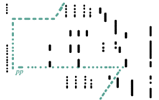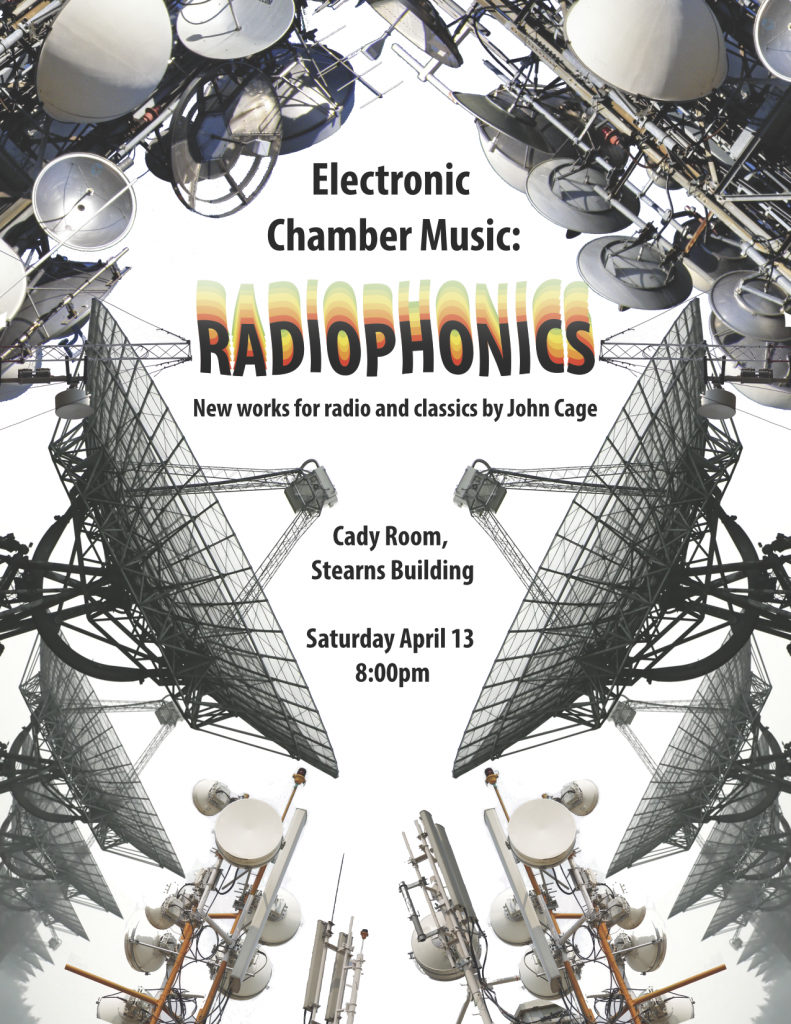My Electronic Chamber Music group’s 2013 Spring Concert — Radiophonics — featured new and classic compositions using radios. Over the course of the semester, we explored the theme of radio: radio as a medium, as a technology, as an institution, as a musical instrument.
Number Stations (2013) by Conor Barry from Michael Gurevich on Vimeo.
Performance by Conor Barry and Brian Kelley from the University of Michigan’s Electronic Chamber Music Spring 2013 concert: Radiophonics, directed by Michael Gurevich. Presented by the Department of Performing Arts Technology, School of Music, Theatre, & Dance.
This choreographed piece for two radios and two performers derives its source material from The Conet Project, a large collection of recordings of “number station” broadcasts. These shortwave radio stations first appeared after WWII, broadcasting mysterious coded messages often in the form of spoken sequences of numbers, to be deciphered by spies in the field. By extracting the rhythmic qualities of these broadcasts, we try to translate these covert messages into actions, oftentimes highlighting their more absurd characteristics.
Different Stations – For Radiophonic Quartet from Michael Gurevich on Vimeo.
Different Stations by Brian Kelley
Different Stations is an improvisation in which one of the voices is particularly unpredictable: live broadcast radio. Through sampling and looping, radiophonic voices are tamed and ordered, becoming an instrument in its own right–-one that requires two performers to play in close coordination. A violinist and pianist must both find and create musical space to coexist with this new radiophonic voice. The title is nod to Steve Reich, from whom the hypnotic rhythmic elements and slowly unfolding form also derive.
Other Works
Hello World by Tom Halpin
An installation piece that greeted the audience at the door, Hello World represents a meta-reflection on the group’s experiences with radio. The voices of the performers are assembled into a radio broadcast that takes the form of a dialog between two radios.
A Conversation Piece by Chris Mathews
Chris Mathews’ new composition explores the experience of liminality in the radiophonic universe. As we move in space, and as the ambient conditions fluctuate, we frequently find ourselves on the edges of a signal’s reach; on the margins of comprehension of the signal’s content. Yet in some senses all radio broadcasts are the same: standardization of content and formats, consolidation of the broadcast industry, and uniform vocal processing result in a lack of distinction from one broadcast to the next.
Waves by Simon Alexander-Adams
A meditation on the wave-particle duality that underlies our understanding of electromagnetic phenomena such as radio, Waves establishes a narrative that is both deeply personal yet unattributable. The piece is about wayfaring and transformation. We traverse a non-place that exists simultaneously in radiophonic space, in the performance environment, and in landscapes of the imagination. But we also experience transformations – radios become ocean waves; and impossible collisions in the multiverse the piece inhabits.
Radio Music (1956) by John Cage (1912-1992)
Cage approached his disdain for radio with a sort of immersion therapy: in his words, with “the same kind of thinking that we ascribe to the cave dwellers in their drawings of frightening animals on the walls–that through making the pictures of them that they would come to terms with them.” His works for radio thus collectively represent an important milestone along the path toward the “liberation of sound” begun by Varèse some 50 years earlier. In embracing radio, Cage came to terms not just with a cultural institution and sonic palette he disliked (as he also did with jazz in Imaginary Landscape no. 5), but with what he saw as the shifting responsibility of the composer he ascribed to Feldman: “from making to accepting.”
Cage’s first work for radios was Imaginary Landscape no. 4 (1951), composed the same year as his first important “chance” composition, Music for Changes. But whereas the randomness of Music for Changes occurred at the time of composition only to be subsequently enshrined in a score, the pieces for radio create an ephemeral and unique soundscape that is unknowable until the instant of performance; one that is not directly contingent on the choices of performers. In the pre-computer era, radio marked the most reliable and sonically rich method for achieving this unpredictability.
Cage described Radio Music as a response to the markedly quiet premiere performance of Imaginary Landscape no. 4. The score for Radio Music instructs performers to set their radios to maximum output level. In this performance, we randomly spiked the FM spectrum with Cagean sonorities: different recordings of Cage’s Sonatas and Interludes were broadcast on 10 FM transmitters blanketing much of the FM spectrum.

